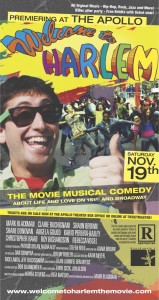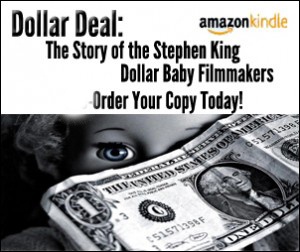“I think it’s great, there’s something real about it… an actual sense of community.” -Marty in Welcome to Harlem
WELCOME TO HARLEM is an indie musical comedy by filmmaker and comedian Mark Blackman. It is his debut feature, shot on location in West Harlem at 151st Street and Broadway. Welcome to Harlem is, by far, one of the most phenomenal achievements I’ve ever seen from an indie filmmaker. I met Mark when we both screened at the 2012 Manhattan Film Festival. He offered me a copy of the film’s soundtrack and promptly informed me of when and where his festival screening was taking place. I attended, sitting next to two Canadian filmmakers who also had films in the festival. The house was half full with people from the neighborhood where Mark produced the project, along with some of the cast, crew and their friends and family. I was blown away and still remain in awe of what he has accomplished on an indie budget.
As of the publication of this article, Welcome to Harlem has not yet been picked up for mainstream distribution. But despite the film’s distribution hardships, the movie has done incredibly well for itself and has earned a neighborhood rooted a loyal fan-base, of which I proudly consider myself a member. Today I present my reasoning for why Welcome to Harlem deserves a Criterion spine.
*Possible Spoilers Below* for anyone who hasn’t seen the movie.
The story of Welcome to Harlem is a spin on your standard “moving to NYC to be an artist” genre and Blackman’s approach & execution is why the movie stands above so many other independent films. The story introduces us to Marty Blackstein, played by Blackman, a young man of the new 20-something generation who laments at the top of the film about how most of Manhattan seems to be less about art and culture and more about money and corruption. Through the course of the opening number, Marty removes the idealized version of NYC from our fragile minds and comes to the conclusion that he can no longer afford to live in the central areas of the the city. Marty decides to take a chance and move uptown to the busy neighborhood of Harlem. Once there, he finds a sea of friendship, love and adventure enveloped in music, dance, grit and one of the most unique neighborhoods (and unique blocks) on the planet. Marty quickly learns that Harlem is not quite what he expected and falls head over heels in love with his new home, neighbors and way of life.
The strongest element of the film is the original music, written by Blackman and musicians Adam Brown and Ryan Gordon. Through his very catchy music, which ranges from hard rock to hip-hop with classic Broadway peppered intermittently, Marty gets involved in disputes, love triangles, block riots and even a sex education field trip that will leave you laughing and cheering with the best of them. Welcome to Harlem is more than just a watchable independent film, it is an EXPERIENCE and an ADVENTURE that only its unique music can give you.
 Mark Blackman is candid when discussing the problems of distribution for today’s independent filmmakers. When I reached out to him about including his film on my Criterion Wish List, his response was of less concern for his work in particular, but more for the independent filmmaking community as a whole. He is an artist that cares about other artists and that’s a welcome attitude that is clearly reflective in his work. “It’s pretty tricky as an up and coming or independent filmmaker” Blackman said, “not because of the limitations of the current system, but because there is no real current system at all. There is an established industry run by gigantic corporate studios who run every aspect of their own projects–from production to marketing and distribution–running on a business model that takes very little into account the quality of the final product.”
Mark Blackman is candid when discussing the problems of distribution for today’s independent filmmakers. When I reached out to him about including his film on my Criterion Wish List, his response was of less concern for his work in particular, but more for the independent filmmaking community as a whole. He is an artist that cares about other artists and that’s a welcome attitude that is clearly reflective in his work. “It’s pretty tricky as an up and coming or independent filmmaker” Blackman said, “not because of the limitations of the current system, but because there is no real current system at all. There is an established industry run by gigantic corporate studios who run every aspect of their own projects–from production to marketing and distribution–running on a business model that takes very little into account the quality of the final product.”
On the subject of distribution, Blackman continued, “There are very close to zero distributors who are actually buying independent films anymore and the ones who are only shop for them at one of three or four major festivals and film markets: Sundance, Toronto, AFM etc. These festivals and marketplace events, while once may have been a launching ground for independent film, have become nothing more than a platform for the major studios to launch their star studded, bigger budget projects. Even Internet distribution is extraordinarily limited, with literally the only platforms accessible to film makers without an aggregator or distributor are Amazon or Vimeo, which even still are very limited in value without an abundance of expensive self promotion.”
The Current Issue
The film is currently available through Amazon’s DVD on Demand service, but this is only a temporary solution for the project. Blackman is currently working with representation to make the film available on iTunes and Netflix, however this is taking time and often negotiations tend to teeter, especially where it concerns going live on Netflix. My goal with this article is to get Welcome to Harlem real, honest home video distribution via a solid DVD release that doesn’t skimp on quality or supplemental material. Blackman insists that all he really wants is an opportunity for more people to hear about and see the film… any which way that’s convenient for them. As a filmmaker and an artist, that’s all that is important to him. Although he’s a bit disappointed with the lack of distribution opportunities for the project, his spirits remain high and he continues to set a positive example for me and many other filmmakers in his network. It’s tough, but it’s worth it.
What Criterion Could Offer
There’s plenty Blackman would love to change or fix (as with almost any piece of work he’s ever produced), but the list of issues that he would go out of my way to fix up for a major release isn’t too long: better audio mastering, maybe a few other small audio fixes, light ADR work and sound effects, color correction improvements.
While the business of finding a distributor for Welcome to Harlem continues, Blackman has informed me that he’s writing the sequel and insists that it’s coming out great. Can’t wait to see it!







